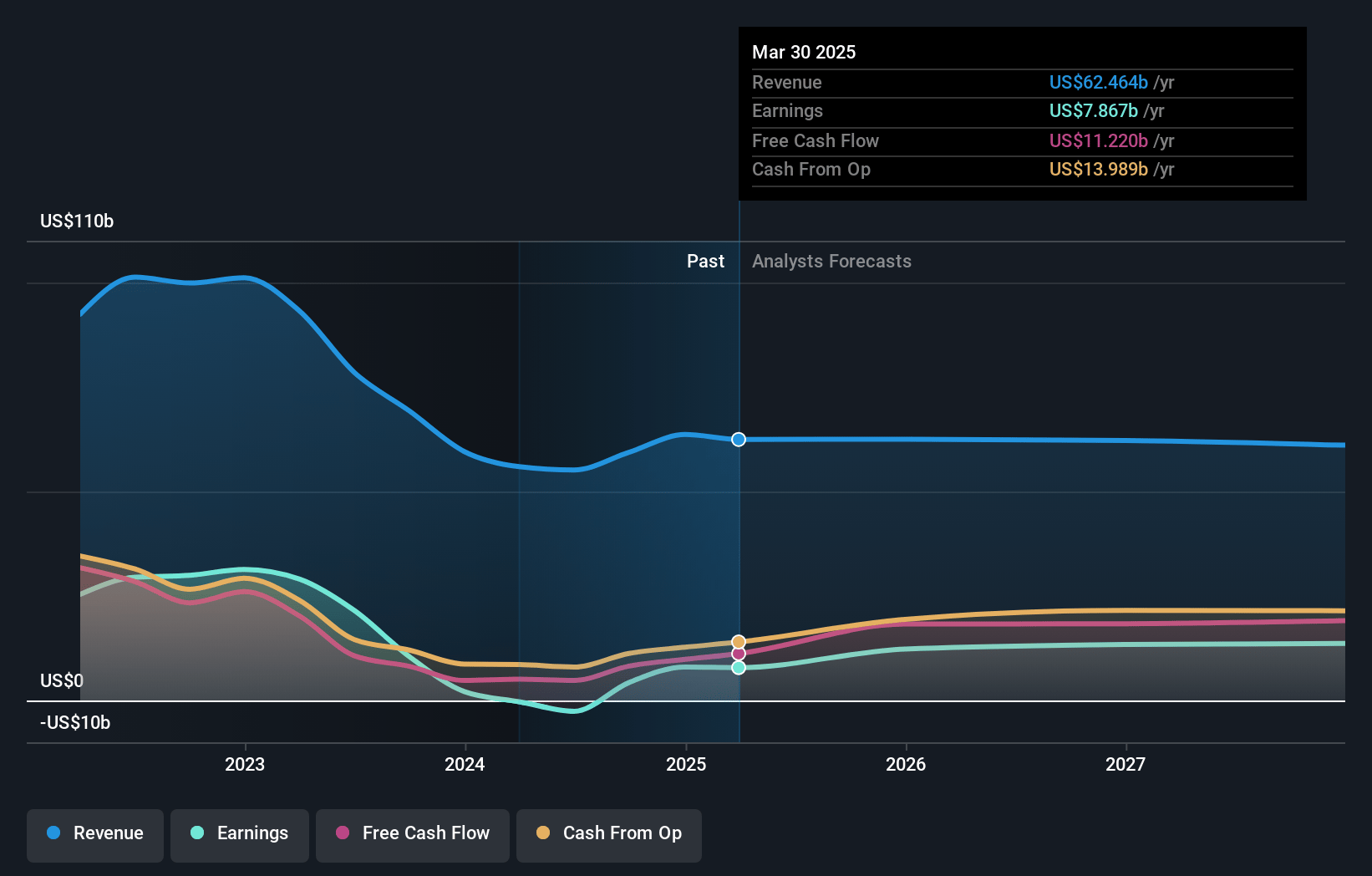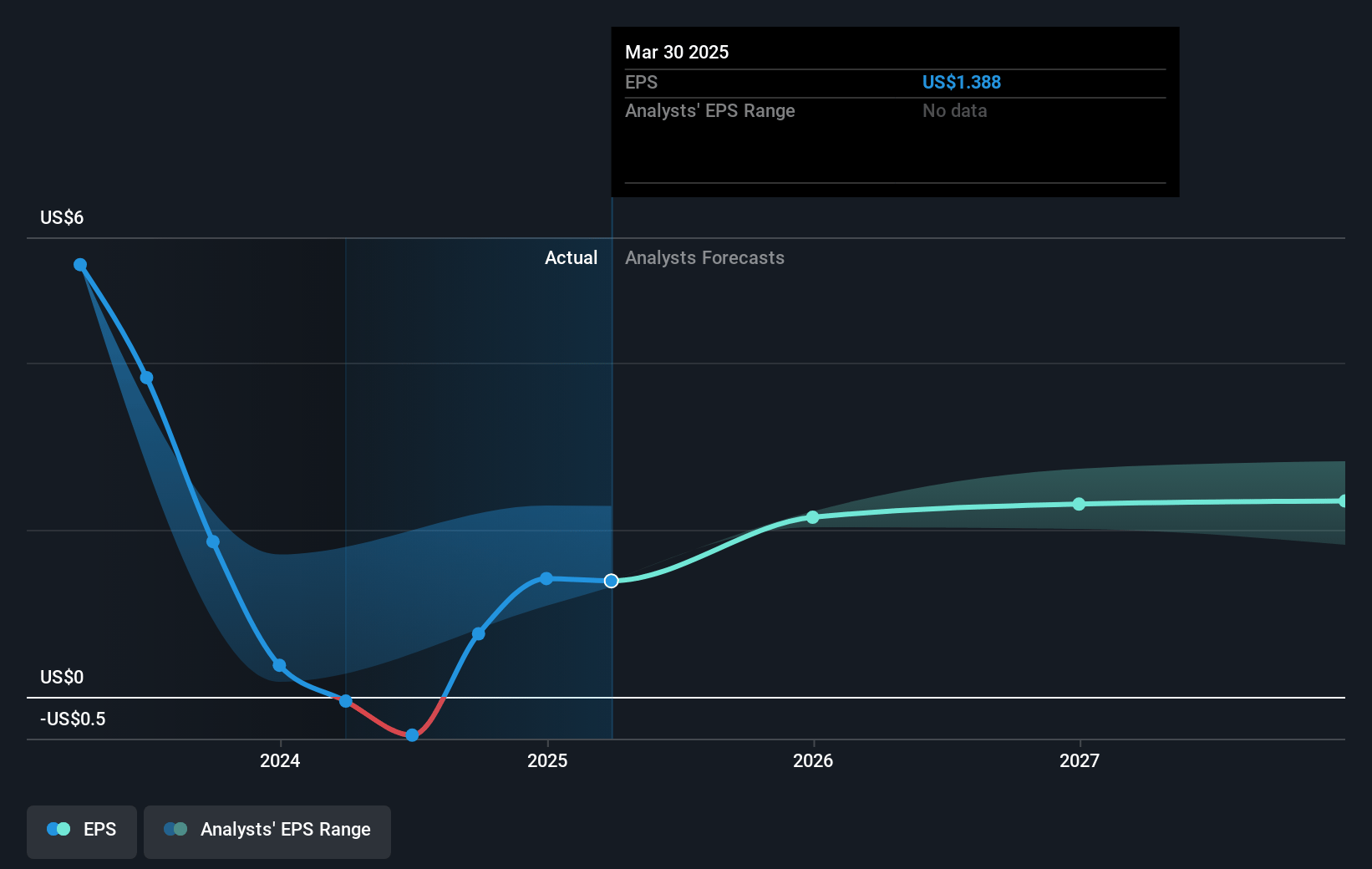Key Takeaways
- Pfizer's R&D focus might slow revenue growth, while cost savings aim to improve margins despite current operational shortfalls.
- Revenue pressures from IRA Medicare changes and stable COVID-19 product earnings may lower growth forecasts.
- Pfizer faces revenue pressures from legislation, COVID-19 volatility, increased competition, R&D challenges, and economic uncertainties impacting global operations.
Catalysts
About Pfizer- Pfizer Inc. discovers, develops, manufactures, markets, distributes, and sells biopharmaceutical products in the United States and internationally.
- Pfizer's shift in focus for 2025 towards improving R&D productivity, while balancing margin expansion and commercial excellence, may result in slower-than-expected revenue growth as these initiatives might take time to yield significant financial impacts.
- The impact of the IRA Medicare Part D redesign, which is expected to be a revenue headwind of approximately $1 billion, could suppress growth prospects and contribute to lower-than-consensus revenue expectations for Pfizer.
- Although Pfizer anticipates starting several Phase III studies and expects multiple regulatory decisions in the coming year, the success of these initiatives is inherently uncertain, which could mean potential setbacks that dampen expected pipeline-driven revenue growth.
- The cost savings programs underway are anticipated to yield significant reductions by the end of 2025 and beyond. However, these could indicate that Pfizer's current operational margins are below expectations, requiring more time and results before they contribute significantly to earnings improvements.
- COVID-19 products are expected to yield stable but non-incremental revenue, potentially diminishing their contribution to Pfizer's overall growth strategy, which may lead to lower-than-forecast earnings projections tied to sustained pandemic-era gains.
Pfizer Future Earnings and Revenue Growth
Assumptions
How have these above catalysts been quantified?- This narrative explores a more pessimistic perspective on Pfizer compared to the consensus, based on a Fair Value that aligns with the bearish cohort of analysts.
- The bearish analysts are assuming Pfizer's revenue will decrease by 2.9% annually over the next 3 years.
- The bearish analysts assume that profit margins will increase from 12.6% today to 17.0% in 3 years time.
- The bearish analysts expect earnings to reach $9.9 billion (and earnings per share of $1.71) by about April 2028, up from $8.0 billion today. The analysts are largely in agreement about this estimate.
- In order for the above numbers to justify the price target of the more bearish analyst cohort, the company would need to trade at a PE ratio of 17.8x on those 2028 earnings, up from 15.9x today. This future PE is greater than the current PE for the US Pharmaceuticals industry at 15.1x.
- Analysts expect the number of shares outstanding to remain consistent over the next 3 years.
- To value all of this in today's terms, we will use a discount rate of 6.21%, as per the Simply Wall St company report.
Pfizer Future Earnings Per Share Growth
Risks
What could happen that would invalidate this narrative?- The impact of the Inflation Reduction Act's Medicare Part D redesign is expected to create a headwind on Pfizer’s revenues by approximately 1.6% versus 2024, particularly affecting high-priced medicines, which may lead to increased gross-to-net impacts early in the year.
- Concerns about COVID-19 revenue volatility and stabilizing patterns in disease burden could affect future revenue streams from the COVID-19 portfolio, which is becoming a smaller contributor to Pfizer's business.
- Despite strategic realignments, there remain significant challenges in transforming and driving future R&D productivity, which is crucial for ensuring robust innovation and enhancing long-term revenue growth.
- Increasing competition from market entrants in key therapeutic areas such as multiple myeloma and breast cancer could dilute Pfizer’s market share and impact revenue from its blockbuster oncology drugs.
- The exchange rate fluctuations and economic uncertainty in international markets could negatively affect global revenue and operational profitability, which Pfizer needs to monitor closely.
Valuation
How have all the factors above been brought together to estimate a fair value?- The assumed bearish price target for Pfizer is $26.02, which represents one standard deviation below the consensus price target of $30.73. This valuation is based on what can be assumed as the expectations of Pfizer's future earnings growth, profit margins and other risk factors from analysts on the more bearish end of the spectrum.
- However, there is a degree of disagreement amongst analysts, with the most bullish reporting a price target of $42.0, and the most bearish reporting a price target of just $24.0.
- In order for you to agree with the bearish analysts, you'd need to believe that by 2028, revenues will be $58.3 billion, earnings will come to $9.9 billion, and it would be trading on a PE ratio of 17.8x, assuming you use a discount rate of 6.2%.
- Given the current share price of $22.49, the bearish analyst price target of $26.02 is 13.6% higher.
- We always encourage you to reach your own conclusions though. So sense check these analyst numbers against your own assumptions and expectations based on your understanding of the business and what you believe is probable.
How well do narratives help inform your perspective?
Disclaimer
AnalystLowTarget is an employee of Simply Wall St, but has written this narrative in their capacity as an individual investor. AnalystLowTarget holds no position in NYSE:PFE. Simply Wall St has no position in the company(s) mentioned. Simply Wall St may provide the securities issuer or related entities with website advertising services for a fee, on an arm's length basis. These relationships have no impact on the way we conduct our business, the content we host, or how our content is served to users. This narrative is general in nature and explores scenarios and estimates created by the author. The narrative does not reflect the opinions of Simply Wall St, and the views expressed are the opinion of the author alone, acting on their own behalf. These scenarios are not indicative of the company's future performance and are exploratory in the ideas they cover. The fair value estimate's are estimations only, and does not constitute a recommendation to buy or sell any stock, and they do not take account of your objectives, or your financial situation. Note that the author's analysis may not factor in the latest price-sensitive company announcements or qualitative material.







